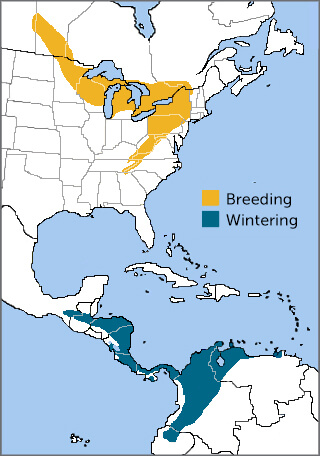
Golden-winged Warbler range map by ABC
The Golden-winged Warbler can be mistaken for a Black-capped Chickadee at first glance, as both species are about the same size, forage in similar ways, and show a bold black mask and bib. However, the Golden-winged Warbler has a longer, thinner bill and splashes of golden-yellow on its crown and wings, which clinch its identification. Male and female Golden-winged Warblers have similar plumage patterns, but the female has more muted colors.
One of the biggest challenges facing this uncommon little warbler is the loss of quality brushy, young forest (or early successional) nesting habitat across much of its breeding range. Another major threat comes from a similar songbird.
Golden-winged Blues
The Golden-winged Warbler often hybridizes with the Blue-winged Warbler, a closely related species. In fact, a 2016 study from the Cornell Lab of Ornithology estimated that these two birds share 99.97 percent of their genetic material. Although the Blue-winged Warbler is generally uncommon, its breeding range has, for decades, been expanding northward into Golden-winged “territory.”
Hybrids of Golden- and Blue-winged Warblers include two distinctive forms known as "Brewster's" and "Lawrence's" Warblers. These birds, which may sing the song of either parent or variations of both, challenge and confuse birders.
Unfortunately, the Golden-winged Warbler is now much more scarce than the Blue-winged and is at risk of being genetically "swamped" by its more numerous and widespread relative where their ranges meet. A recent study suggests that the continued existence of both species will require conservation that somehow keeps the two isolated from one another.
Succeeding in Successional Habitats
During its nesting season, the Golden-winged Warbler may be found in the Great Lakes states, the central and southern Appalachians, and southern Canada. Like other North American wood-warblers, it's a long-distance migrant, traveling to Central America and northern South America for the winter.
This small warbler breeds most successfully in dense, early successional habitats shared by bird species such as the Prairie Warbler, Common Yellowthroat, Indigo Bunting, and American Woodcock. These habitats may include old fields and orchards, open scrubland and marshes with scattered trees, and young forest resulting from natural disturbance or timber harvesting. Golden-winged Warbler breeding territories need to be adjacent to older forest, where young birds, after fledging, continue to mature while feasting on a bounty of caterpillars and other insects.
This warbler's thin, buzzy, rather quiet song can easily be missed, or mistaken for that of another species. The presence of Blue-winged and/or hybrid warblers can complicate song identification even further. Listen below and see if you agree:
(Andrew Spencer, XC48305. Accessible at www.xeno-canto.org/48305 · Andrew Spencer, XC48269. Accessible at www.xeno-canto.org/48269 · Christopher McPherson, XC598819. Accessible at www.xeno-canto.org/598819 · Martin St-Michel, XC329965. Accessible at www.xeno-canto.org/329965)
Golden Gleaners
The Golden-winged Warbler is an active and acrobatic species, often sighted dangling upside-down as it forages, like a Tufted Titmouse or White-breasted Nuthatch. It typically probes curled-up leaves or gleans leaves and stems for moths and their larvae, spiders, and other invertebrates. Unlike the American Redstart or Cape May Warbler, the Golden-winged Warbler rarely pursues flying insects or drinks nectar.
Dedicated Parents
Like the Kentucky Warbler and Ovenbird, the Golden-winged Warbler nests on or near the ground, often in a shaded forest or field edge. The female conceals her cup-shaped nest of leaves, bark, and grasses at the base of a small woody stem or in a thick clump of vegetation, lining the structure with soft hair or animal fur. She is sensitive to disturbance while nest-building, and may abandon a site during construction or even while egg-laying. Once her clutch of (usually) five eggs has been laid, the female sits tight, even when closely approached.

Female Golden-winged Warbler during migration, in Galveston, Texas. Photo by Agami Photo Agency, Shutterstock
Both male and female Golden-winged Warblers feed the nestlings after they hatch. If the adults detect a potential predator near the nest, they try to draw it away by repeatedly chipping loudly and carrying food to another spot.
Young birds leave the nest (fledge) after about nine days, and once they are all out, the mother and father split the brood, taking them in different directions. They move into sapling stands and older forest with dense understory, which provide greater protection and abundant caterpillar prey. The parent birds continue to accompany and feed their young for about a month after they fledge.
A Deep Dive
The Golden-winged Warbler has suffered one of the steepest population declines of any songbird — a 66-percent reduction since 1966 — primarily due to loss of the early-successional forest habitat it requires for successful breeding. As mentioned above, it also suffers from competition with Blue-winged Warblers, but also cowbird parasitism and the loss of wintering habitat in Latin America.
ABC is a member of the Golden-winged Warbler Working Group, which has released conservation blueprints with the goal of boosting the warbler's numbers by 50 percent within the next 50 years.
With partners, we're restoring habitat through forest management in Wisconsin, Michigan, Minnesota, Pennsylvania, Maryland, Tennessee, and North Carolina. We participate in the Appalachian Regional Reforestation Initiative, a coalition working to restore forests on reclaimed mine sites in association with the ABC-supported Appalachian Mountains Joint Venture.
The Golden-winged Warbler is also one of nine focal species for the USDA Natural Resources Conservation Services' (NRCS's) Working Lands For Wildlife (WLFW) program. Between 2012 and 2020, ABC assisted NRCS with enrolling more than 23,500 acres of private forest land in WLFW.
In Nicaragua, we're working with the owners of El Jaguar Reserve to improve and protect habitat in a conservation corridor for the Golden-winged Warbler. ABC is involved in a number of other large-scale conservation initiatives that benefit the Golden-winged Warbler, including BirdScapes and Joint Ventures, which concentrate on the protection, recovery, and enhancement of quality habitat on this beautiful warbler's breeding, stopover, and wintering grounds.
Donate to support ABC's conservation mission!



















































